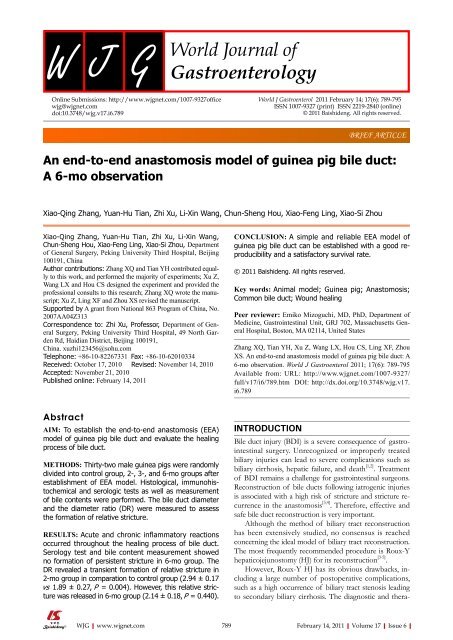and HBeAg(-) patients - World Journal of Gastroenterology
and HBeAg(-) patients - World Journal of Gastroenterology
and HBeAg(-) patients - World Journal of Gastroenterology
Create successful ePaper yourself
Turn your PDF publications into a flip-book with our unique Google optimized e-Paper software.
Online Submissions: http://www.wjgnet.com/1007-9327<strong>of</strong>fice<br />
wjg@wjgnet.com<br />
doi:10.3748/wjg.v17.i6.789<br />
An end-to-end anastomosis model <strong>of</strong> guinea pig bile duct:<br />
A 6-mo observation<br />
Xiao-Qing Zhang, Yuan-Hu Tian, Zhi Xu, Li-Xin Wang, Chun-Sheng Hou, Xiao-Feng Ling, Xiao-Si Zhou<br />
Xiao-Qing Zhang, Yuan-Hu Tian, Zhi Xu, Li-Xin Wang,<br />
Chun-Sheng Hou, Xiao-Feng Ling, Xiao-Si Zhou, Department<br />
<strong>of</strong> General Surgery, Peking University Third Hospital, Beijing<br />
100191, China<br />
Author contributions: Zhang XQ <strong>and</strong> Tian YH contributed equally<br />
to this work, <strong>and</strong> performed the majority <strong>of</strong> experiments; Xu Z,<br />
Wang LX <strong>and</strong> Hou CS designed the experiment <strong>and</strong> provided the<br />
pr<strong>of</strong>essional consults to this research; Zhang XQ wrote the manuscript;<br />
Xu Z, Ling XF <strong>and</strong> Zhou XS revised the manuscript.<br />
Supported by A grant from National 863 Program <strong>of</strong> China, No.<br />
2007AA04Z313<br />
Correspondence to: Zhi Xu, Pr<strong>of</strong>essor, Department <strong>of</strong> General<br />
Surgery, Peking University Third Hospital, 49 North Garden<br />
Rd, Haidian District, Beijing 100191,<br />
China. xuzhi123456@sohu.com<br />
Telephone: +86-10-82267331 Fax: +86-10-62010334<br />
Received: October 17, 2010 Revised: November 14, 2010<br />
Accepted: November 21, 2010<br />
Published online: February 14, 2011<br />
Abstract<br />
AIM: To establish the end-to-end anastomosis (EEA)<br />
model <strong>of</strong> guinea pig bile duct <strong>and</strong> evaluate the healing<br />
process <strong>of</strong> bile duct.<br />
METHODS: Thirty-two male guinea pigs were r<strong>and</strong>omly<br />
divided into control group, 2-, 3-, <strong>and</strong> 6-mo groups after<br />
establishment <strong>of</strong> EEA model. Histological, immunohistochemical<br />
<strong>and</strong> serologic tests as well as measurement<br />
<strong>of</strong> bile contents were performed. The bile duct diameter<br />
<strong>and</strong> the diameter ratio (DR) were measured to assess<br />
the formation <strong>of</strong> relative stricture.<br />
RESULTS: Acute <strong>and</strong> chronic inflammatory reactions<br />
occurred throughout the healing process <strong>of</strong> bile duct.<br />
Serology test <strong>and</strong> bile content measurement showed<br />
no formation <strong>of</strong> persistent stricture in 6-mo group. The<br />
DR revealed a transient formation <strong>of</strong> relative stricture in<br />
2-mo group in comparation to control group (2.94 ± 0.17<br />
vs 1.89 ± 0.27, P = 0.004). However, this relative stricture<br />
was released in 6-mo group (2.14 ± 0.18, P = 0.440).<br />
WJG|www.wjgnet.com<br />
<strong>World</strong> J Gastroenterol 2011 February 14; 17(6): 789-795<br />
ISSN 1007-9327 (print) ISSN 2219-2840 (online)<br />
© 2011 Baishideng. All rights reserved.<br />
CONCLUSION: A simple <strong>and</strong> reliable EEA model <strong>of</strong><br />
guinea pig bile duct can be established with a good reproducibility<br />
<strong>and</strong> a satisfactory survival rate.<br />
© 2011 Baishideng. All rights reserved.<br />
Key words: Animal model; Guinea pig; Anastomosis;<br />
Common bile duct; Wound healing<br />
Peer reviewer: Emiko Mizoguchi, MD, PhD, Department <strong>of</strong><br />
Medicine, Gastrointestinal Unit, GRJ 702, Massachusetts General<br />
Hospital, Boston, MA 02114, United States<br />
Zhang XQ, Tian YH, Xu Z, Wang LX, Hou CS, Ling XF, Zhou<br />
XS. An end-to-end anastomosis model <strong>of</strong> guinea pig bile duct: A<br />
6-mo observation. <strong>World</strong> J Gastroenterol 2011; 17(6): 789-795<br />
Available from: URL: http://www.wjgnet.com/1007-9327/<br />
full/v17/i6/789.htm DOI: http://dx.doi.org/10.3748/wjg.v17.<br />
i6.789<br />
INTRODUCTION<br />
BRIEF ARTICLE<br />
Bile duct injury (BDI) is a severe consequence <strong>of</strong> gastrointestinal<br />
surgery. Unrecognized or improperly treated<br />
biliary injuries can lead to severe complications such as<br />
biliary cirrhosis, hepatic failure, <strong>and</strong> death [1,2] . Treatment<br />
<strong>of</strong> BDI remains a challenge for gastrointestinal surgeons.<br />
Reconstruction <strong>of</strong> bile ducts following iatrogenic injuries<br />
is associated with a high risk <strong>of</strong> stricture <strong>and</strong> stricture recurrence<br />
in the anastomosis [3,4] . Therefore, effective <strong>and</strong><br />
safe bile duct reconstruction is very important.<br />
Although the method <strong>of</strong> biliary tract reconstruction<br />
has been extensively studied, no consensus is reached<br />
concerning the ideal model <strong>of</strong> biliary tract reconstruction.<br />
The most frequently recommended procedure is Roux-Y<br />
hepaticojejunostomy (HJ) for its reconstruction [3-5] .<br />
However, Roux-Y HJ has its obvious drawbacks, including<br />
a large number <strong>of</strong> postoperative complications,<br />
such as a high occurrence <strong>of</strong> biliary tract stenosis leading<br />
to secondary biliary cirrhosis. The diagnostic <strong>and</strong> thera-<br />
789 February 14, 2011|Volume 17|Issue 6|

















